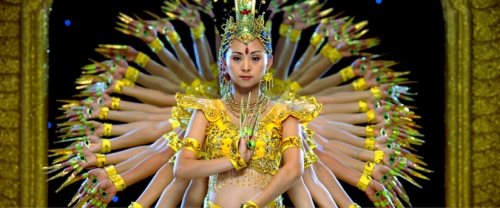A planet-sized coffee-table book of a film, the 99-minute Samsara by Ron Fricke and Mark Magidson routes unnarrated, untitled footage from 25 countries through a lens drawn to repetition, patterns and epic scale. Many of its 70-millimeter frames could pass for photographs by Andreas Gursky or Edward Burtynsky. One scene looks like it was shot in the same chicken-processing factory in China that Burtynsky documented in 2005.
Collated with these postcards for overpopulation and consumerism are portraits of men, women and children with penetrating stares. By the time Samsara ends, we’ve met dozens of today’s Sharbat Gulas: a maimed veteran whose entire head looks rebuilt through plastic surgery; a Himba woman from Namibia; a dancer at the front of a line performing the Guanyin dance of a thousand arms; a white man and two teenagers, presumably American, posed proudly with their rifles in a garage.
Samsara vacillates between an indictment of what we’ve done to the world — and to ourselves in the process — and wide-eyed wonder at the glorious mess of it all. Grand civic, religious and royal architectures receive similar treatment to natural wonders like glaciers and Arches National Park. (Shots of cliff dwellings at Betatakin, in Arizona, and carved-from-rock facades at Petra, in Jordan, bridge the gap, as we see in details how these miracles of the built environment are being reclaimed by time. A brief glimpse of Mali stings, as holy sites there were damaged this summer by Islamist Ansar Dine militants.)
This journey extends a branch of globally minded, somewhat abstracted documentary filmmaking that began 30 years ago with Godfrey Reggio’s Koyaanisqatsi, for which Fricke was cinematographer. Fricke and Magidson collaborated on the subsequent Chronos (1985) and Baraka (1992) and Samsara feels familiar, if you’ve seen those two films, not least because they share some names in the soundtrack department (Michael Stearns, Lisa Gerrard of Dead Can Dance).
In its strongest stretches, Samsara locates our world’s borders, temporary and eternal, philosophical and concrete. Stunning aerial views show where favelas and luxury high-rises meet in Brazil, and where a wall divides Israel and the predominantly Palestinian West Bank. Time-lapse photography captures day becoming night above the stone finials on the roof of a Gothic cathedral. The camera pans across hauntingly still, deserted schools, shops and homes destroyed by Hurricane Katrina and blanketed with mud split geometrically by desiccation cracks. The film’s second scene is an immersive view of an erupting volcano, a place where the planet’s vast, hot interior bursts forth through a relatively thin, shifting crust.
With its steadily metered rhythm of cuts between slow tracking shots and tableaux, Samsara slides early on into a leisurely, page-flipping pace. Its images are seldom less than gut-punching, shocking and arresting but Fricke and Magidson, its co-editors, are always there to hold your hand. It remains, from beginning to end, a Guided Tour of Earth in the Early Twenty-First Century. Even its most potentially upsetting subjects — poverty, mass production, incarceration — are displayed in ways that foreground the mechanics and orders of those systems, rather than identifying and communicating their effects on living beings.
That’s an expected handicap for a film in which no one talks. A sort of exception is a cameo by French performance artist Olivier de Sagazan, who desperately tries different masks made of wet clay he slaps on and scrapes or shakes violently off of his face. His work is a jolt, discordant with the rest of Samsara (a Sanskrit word for the ongoing cycle of reincarnation). We watch Tibetan monks painstakingly create a mandala out of colored sand, then see them ruin it and scoop most of the grains into a little bowl. Their ritual is one of peace, calm and acceptance. De Sagazan’s performance suggests he’s trapped, bound by chains that must be broken.
An exclusive engagement of Samsara in Chicago opens September 7 at the Landmark Century Centre Cinema (2828 N Clark St). The film shows in New York City and Seattle beginning August 24; further release dates are available here. This post was updated after publishing for clarity. View the trailer below.



Leave a comment